Strategic Management Report: Oman Oil Company's Outsourcing Strategies
VerifiedAdded on 2020/04/15
|26
|5638
|262
Report
AI Summary
This report offers a comprehensive strategic analysis of the Oman Oil Company, examining its current operations, internal and external environments, and competitive advantages. It delves into the company's strengths, weaknesses, opportunities, and threats (SWOT) and evaluates its strategic position using the Bowman Strategy Clock. The report highlights potential outsourcing opportunities, particularly in process planning and manufacturing engineering services, to enhance cost-effectiveness and resilience to market changes. It explores various strategic choices, including integration and diversification, and provides recommendations to improve profitability and maintain a competitive edge in the oil and gas industry. The analysis considers the macro and micro environments, value chain, and the impact of global market dynamics on the company's performance. This report provides a detailed overview of the company's challenges, and strategic options for future growth.
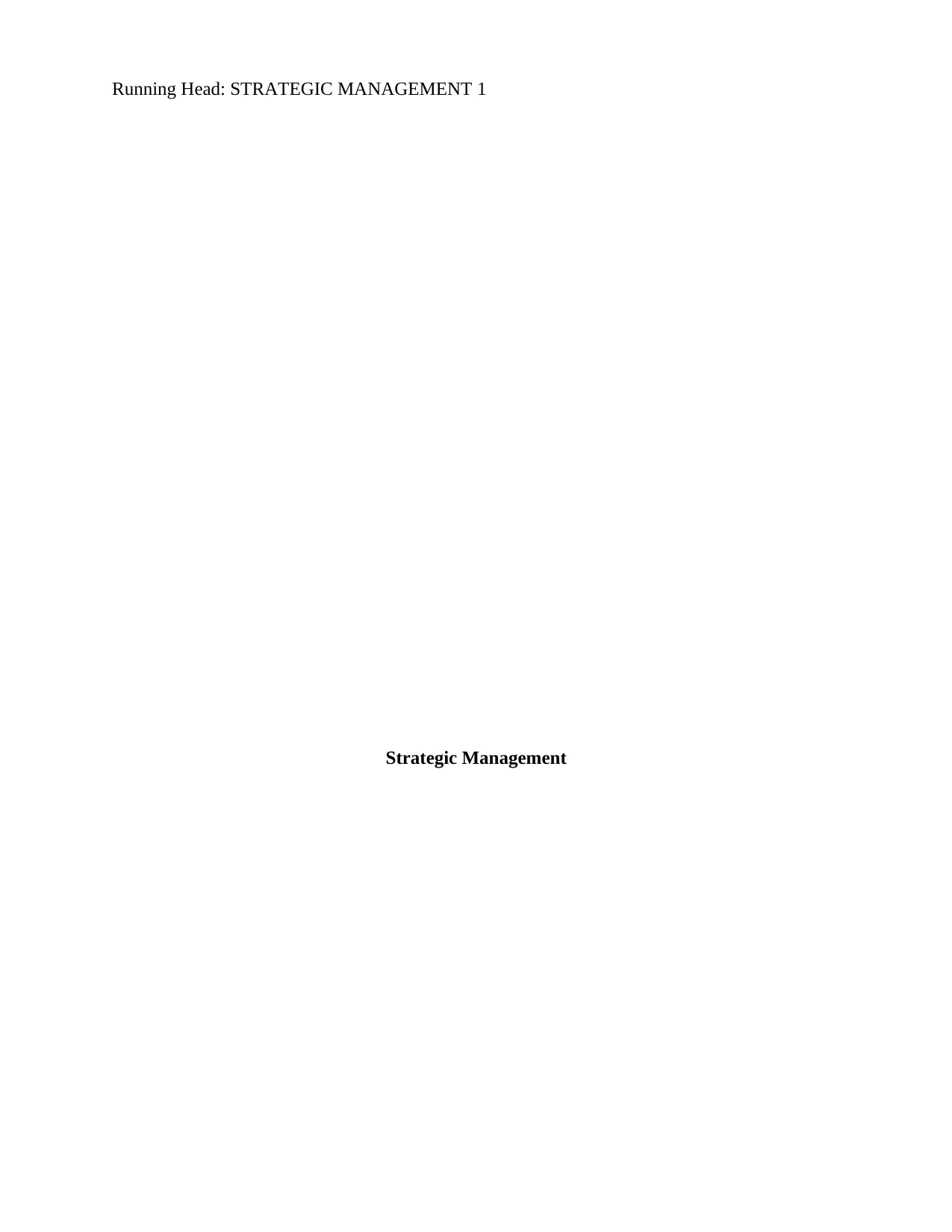
Running Head: STRATEGIC MANAGEMENT 1
Strategic Management
Strategic Management
Paraphrase This Document
Need a fresh take? Get an instant paraphrase of this document with our AI Paraphraser
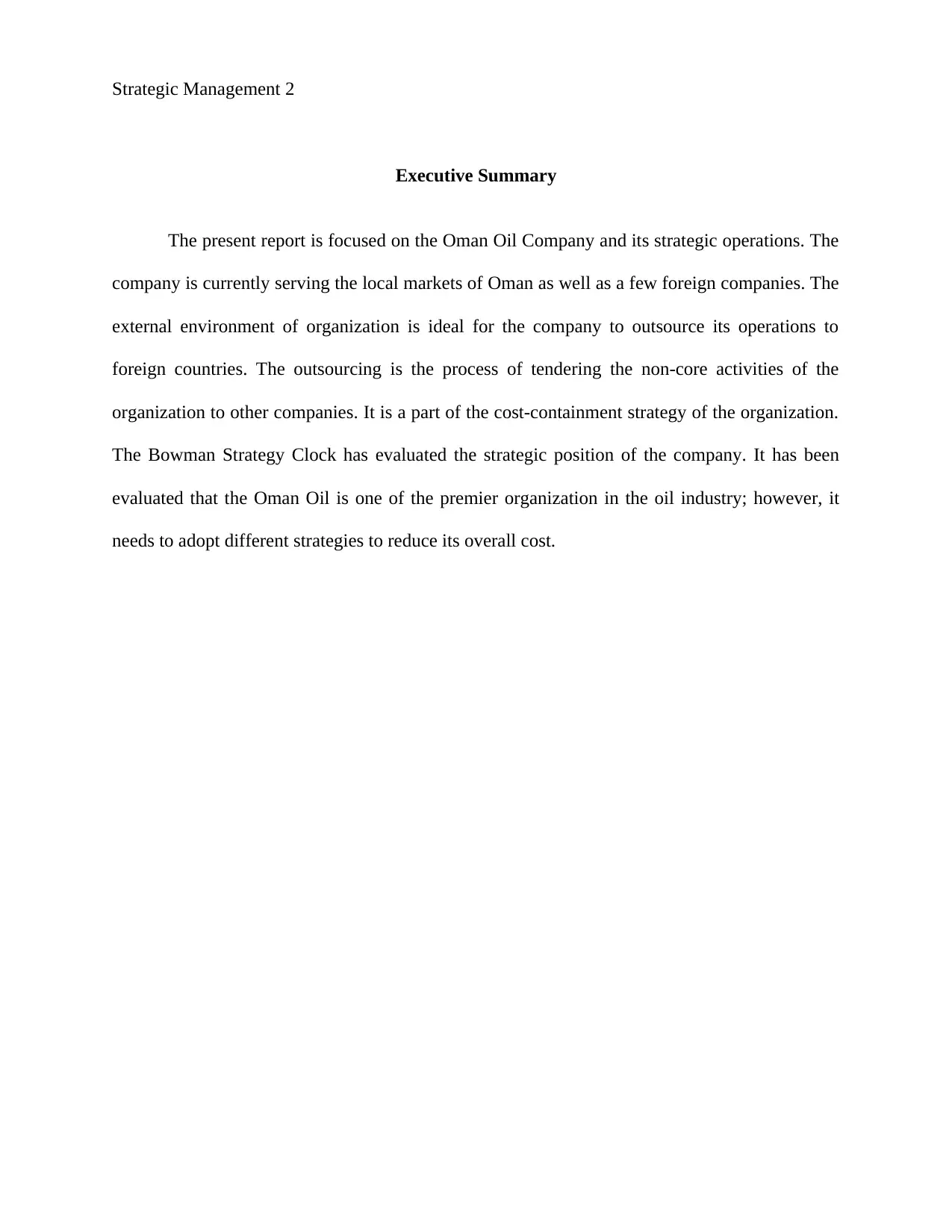
Strategic Management 2
Executive Summary
The present report is focused on the Oman Oil Company and its strategic operations. The
company is currently serving the local markets of Oman as well as a few foreign companies. The
external environment of organization is ideal for the company to outsource its operations to
foreign countries. The outsourcing is the process of tendering the non-core activities of the
organization to other companies. It is a part of the cost-containment strategy of the organization.
The Bowman Strategy Clock has evaluated the strategic position of the company. It has been
evaluated that the Oman Oil is one of the premier organization in the oil industry; however, it
needs to adopt different strategies to reduce its overall cost.
Executive Summary
The present report is focused on the Oman Oil Company and its strategic operations. The
company is currently serving the local markets of Oman as well as a few foreign companies. The
external environment of organization is ideal for the company to outsource its operations to
foreign countries. The outsourcing is the process of tendering the non-core activities of the
organization to other companies. It is a part of the cost-containment strategy of the organization.
The Bowman Strategy Clock has evaluated the strategic position of the company. It has been
evaluated that the Oman Oil is one of the premier organization in the oil industry; however, it
needs to adopt different strategies to reduce its overall cost.
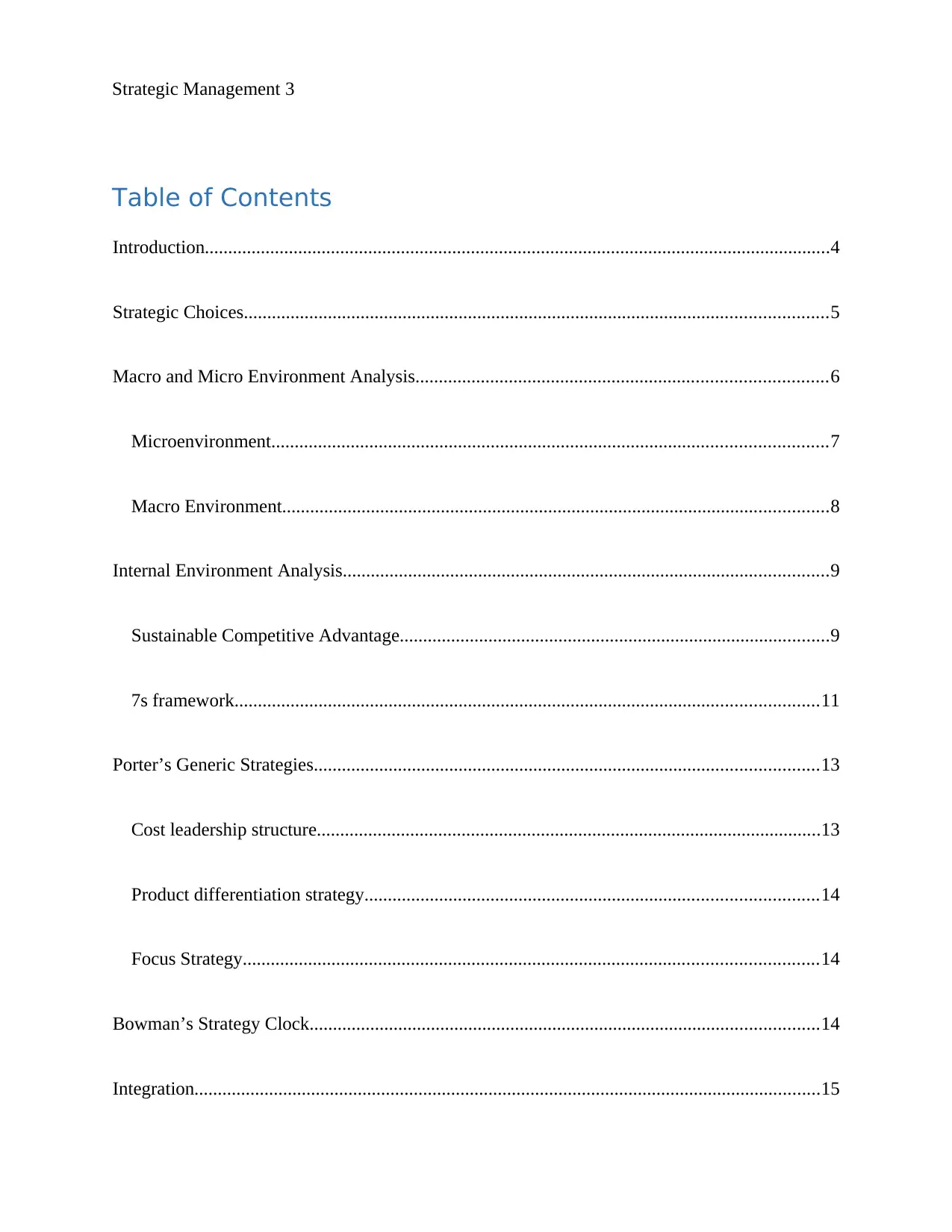
Strategic Management 3
Table of Contents
Introduction......................................................................................................................................4
Strategic Choices.............................................................................................................................5
Macro and Micro Environment Analysis........................................................................................6
Microenvironment.......................................................................................................................7
Macro Environment.....................................................................................................................8
Internal Environment Analysis........................................................................................................9
Sustainable Competitive Advantage............................................................................................9
7s framework.............................................................................................................................11
Porter’s Generic Strategies............................................................................................................13
Cost leadership structure............................................................................................................13
Product differentiation strategy.................................................................................................14
Focus Strategy...........................................................................................................................14
Bowman’s Strategy Clock.............................................................................................................14
Integration......................................................................................................................................15
Table of Contents
Introduction......................................................................................................................................4
Strategic Choices.............................................................................................................................5
Macro and Micro Environment Analysis........................................................................................6
Microenvironment.......................................................................................................................7
Macro Environment.....................................................................................................................8
Internal Environment Analysis........................................................................................................9
Sustainable Competitive Advantage............................................................................................9
7s framework.............................................................................................................................11
Porter’s Generic Strategies............................................................................................................13
Cost leadership structure............................................................................................................13
Product differentiation strategy.................................................................................................14
Focus Strategy...........................................................................................................................14
Bowman’s Strategy Clock.............................................................................................................14
Integration......................................................................................................................................15
⊘ This is a preview!⊘
Do you want full access?
Subscribe today to unlock all pages.

Trusted by 1+ million students worldwide
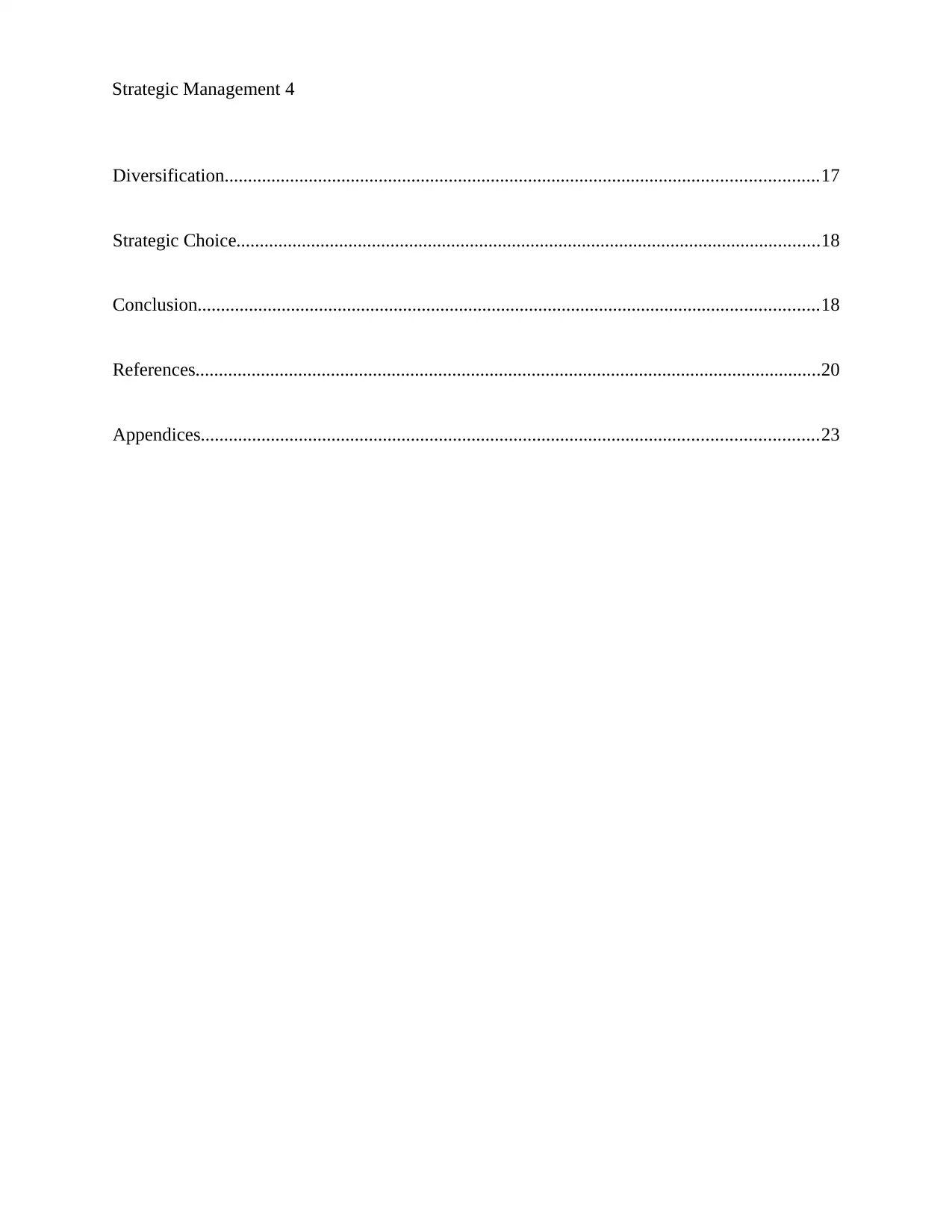
Strategic Management 4
Diversification...............................................................................................................................17
Strategic Choice.............................................................................................................................18
Conclusion.....................................................................................................................................18
References......................................................................................................................................20
Appendices....................................................................................................................................23
Diversification...............................................................................................................................17
Strategic Choice.............................................................................................................................18
Conclusion.....................................................................................................................................18
References......................................................................................................................................20
Appendices....................................................................................................................................23
Paraphrase This Document
Need a fresh take? Get an instant paraphrase of this document with our AI Paraphraser
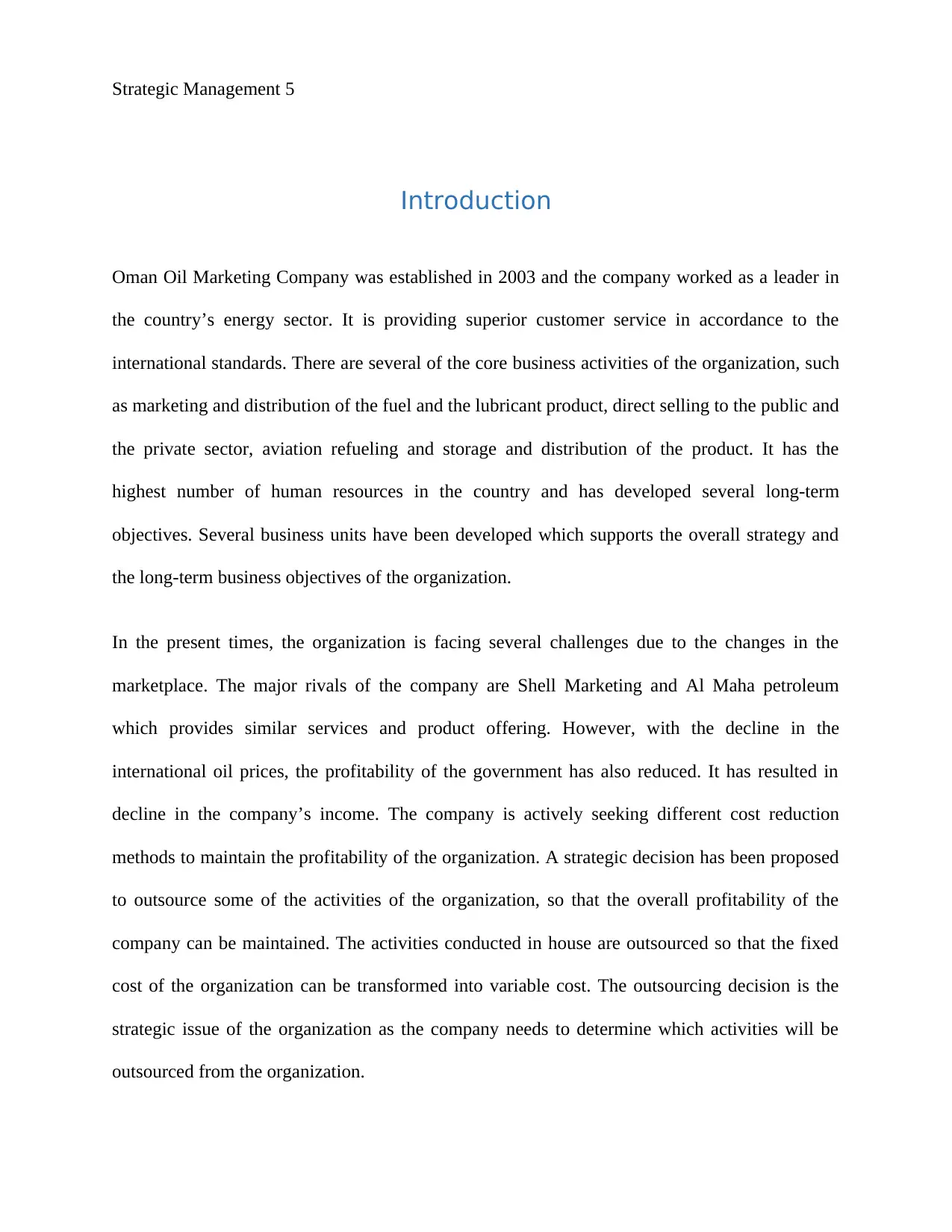
Strategic Management 5
Introduction
Oman Oil Marketing Company was established in 2003 and the company worked as a leader in
the country’s energy sector. It is providing superior customer service in accordance to the
international standards. There are several of the core business activities of the organization, such
as marketing and distribution of the fuel and the lubricant product, direct selling to the public and
the private sector, aviation refueling and storage and distribution of the product. It has the
highest number of human resources in the country and has developed several long-term
objectives. Several business units have been developed which supports the overall strategy and
the long-term business objectives of the organization.
In the present times, the organization is facing several challenges due to the changes in the
marketplace. The major rivals of the company are Shell Marketing and Al Maha petroleum
which provides similar services and product offering. However, with the decline in the
international oil prices, the profitability of the government has also reduced. It has resulted in
decline in the company’s income. The company is actively seeking different cost reduction
methods to maintain the profitability of the organization. A strategic decision has been proposed
to outsource some of the activities of the organization, so that the overall profitability of the
company can be maintained. The activities conducted in house are outsourced so that the fixed
cost of the organization can be transformed into variable cost. The outsourcing decision is the
strategic issue of the organization as the company needs to determine which activities will be
outsourced from the organization.
Introduction
Oman Oil Marketing Company was established in 2003 and the company worked as a leader in
the country’s energy sector. It is providing superior customer service in accordance to the
international standards. There are several of the core business activities of the organization, such
as marketing and distribution of the fuel and the lubricant product, direct selling to the public and
the private sector, aviation refueling and storage and distribution of the product. It has the
highest number of human resources in the country and has developed several long-term
objectives. Several business units have been developed which supports the overall strategy and
the long-term business objectives of the organization.
In the present times, the organization is facing several challenges due to the changes in the
marketplace. The major rivals of the company are Shell Marketing and Al Maha petroleum
which provides similar services and product offering. However, with the decline in the
international oil prices, the profitability of the government has also reduced. It has resulted in
decline in the company’s income. The company is actively seeking different cost reduction
methods to maintain the profitability of the organization. A strategic decision has been proposed
to outsource some of the activities of the organization, so that the overall profitability of the
company can be maintained. The activities conducted in house are outsourced so that the fixed
cost of the organization can be transformed into variable cost. The outsourcing decision is the
strategic issue of the organization as the company needs to determine which activities will be
outsourced from the organization.
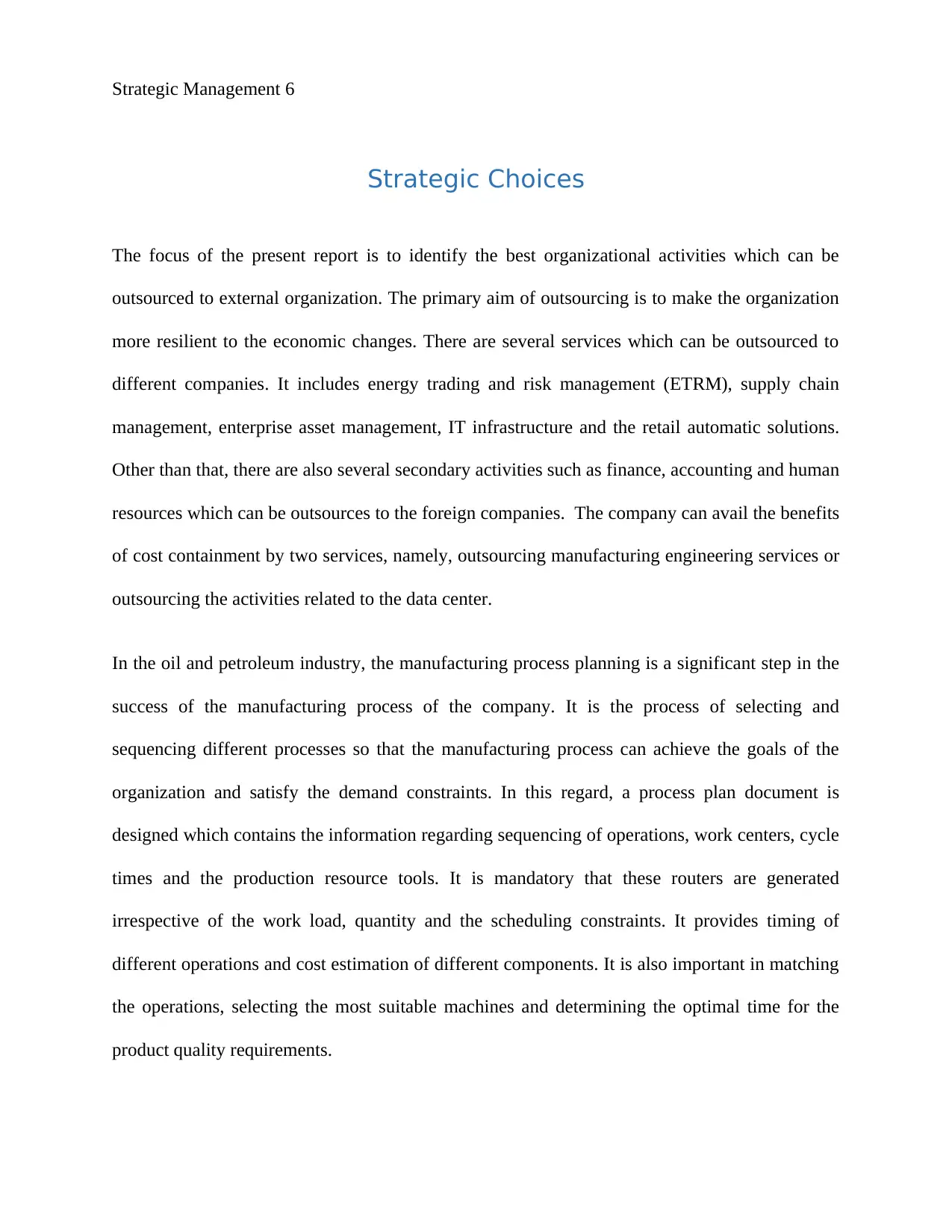
Strategic Management 6
Strategic Choices
The focus of the present report is to identify the best organizational activities which can be
outsourced to external organization. The primary aim of outsourcing is to make the organization
more resilient to the economic changes. There are several services which can be outsourced to
different companies. It includes energy trading and risk management (ETRM), supply chain
management, enterprise asset management, IT infrastructure and the retail automatic solutions.
Other than that, there are also several secondary activities such as finance, accounting and human
resources which can be outsources to the foreign companies. The company can avail the benefits
of cost containment by two services, namely, outsourcing manufacturing engineering services or
outsourcing the activities related to the data center.
In the oil and petroleum industry, the manufacturing process planning is a significant step in the
success of the manufacturing process of the company. It is the process of selecting and
sequencing different processes so that the manufacturing process can achieve the goals of the
organization and satisfy the demand constraints. In this regard, a process plan document is
designed which contains the information regarding sequencing of operations, work centers, cycle
times and the production resource tools. It is mandatory that these routers are generated
irrespective of the work load, quantity and the scheduling constraints. It provides timing of
different operations and cost estimation of different components. It is also important in matching
the operations, selecting the most suitable machines and determining the optimal time for the
product quality requirements.
Strategic Choices
The focus of the present report is to identify the best organizational activities which can be
outsourced to external organization. The primary aim of outsourcing is to make the organization
more resilient to the economic changes. There are several services which can be outsourced to
different companies. It includes energy trading and risk management (ETRM), supply chain
management, enterprise asset management, IT infrastructure and the retail automatic solutions.
Other than that, there are also several secondary activities such as finance, accounting and human
resources which can be outsources to the foreign companies. The company can avail the benefits
of cost containment by two services, namely, outsourcing manufacturing engineering services or
outsourcing the activities related to the data center.
In the oil and petroleum industry, the manufacturing process planning is a significant step in the
success of the manufacturing process of the company. It is the process of selecting and
sequencing different processes so that the manufacturing process can achieve the goals of the
organization and satisfy the demand constraints. In this regard, a process plan document is
designed which contains the information regarding sequencing of operations, work centers, cycle
times and the production resource tools. It is mandatory that these routers are generated
irrespective of the work load, quantity and the scheduling constraints. It provides timing of
different operations and cost estimation of different components. It is also important in matching
the operations, selecting the most suitable machines and determining the optimal time for the
product quality requirements.
⊘ This is a preview!⊘
Do you want full access?
Subscribe today to unlock all pages.

Trusted by 1+ million students worldwide
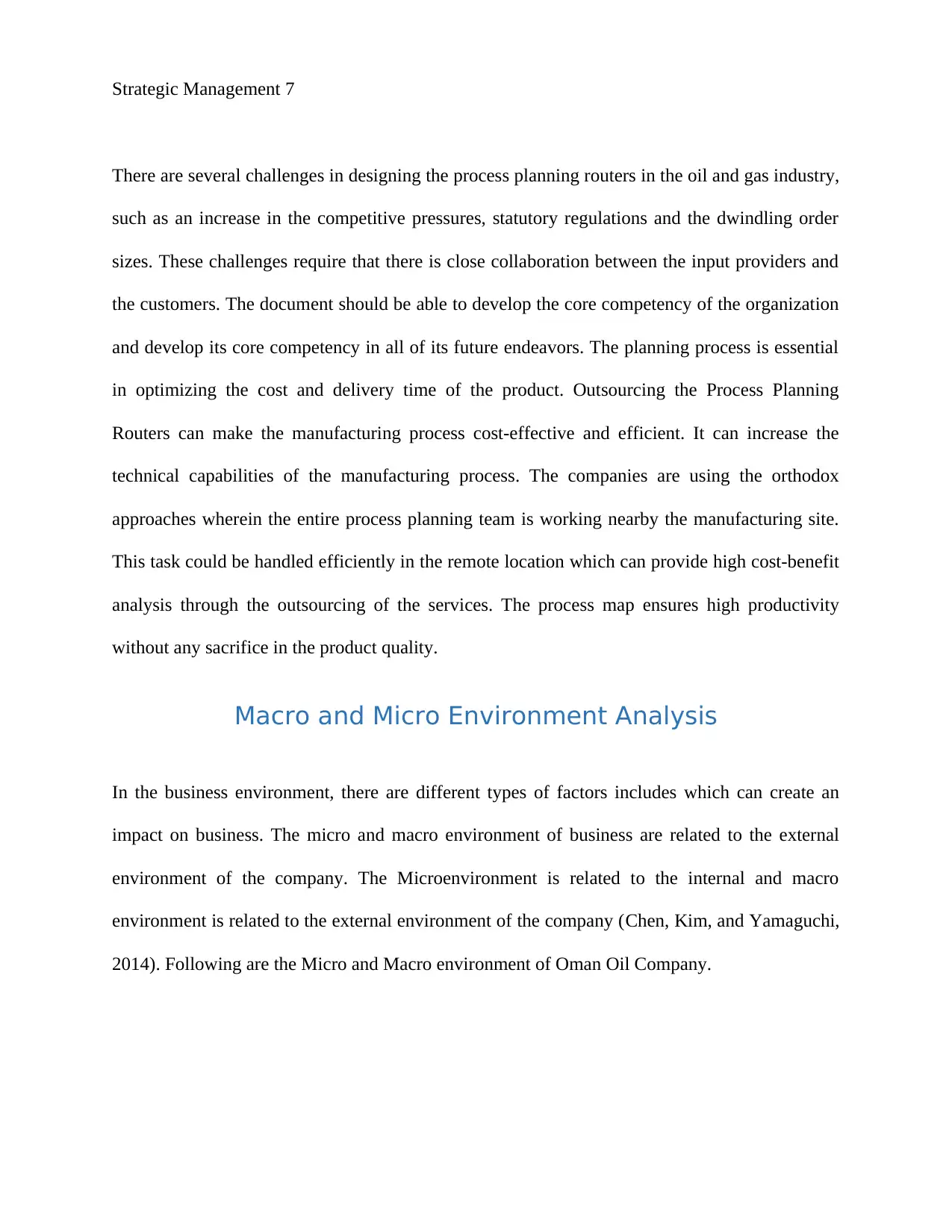
Strategic Management 7
There are several challenges in designing the process planning routers in the oil and gas industry,
such as an increase in the competitive pressures, statutory regulations and the dwindling order
sizes. These challenges require that there is close collaboration between the input providers and
the customers. The document should be able to develop the core competency of the organization
and develop its core competency in all of its future endeavors. The planning process is essential
in optimizing the cost and delivery time of the product. Outsourcing the Process Planning
Routers can make the manufacturing process cost-effective and efficient. It can increase the
technical capabilities of the manufacturing process. The companies are using the orthodox
approaches wherein the entire process planning team is working nearby the manufacturing site.
This task could be handled efficiently in the remote location which can provide high cost-benefit
analysis through the outsourcing of the services. The process map ensures high productivity
without any sacrifice in the product quality.
Macro and Micro Environment Analysis
In the business environment, there are different types of factors includes which can create an
impact on business. The micro and macro environment of business are related to the external
environment of the company. The Microenvironment is related to the internal and macro
environment is related to the external environment of the company (Chen, Kim, and Yamaguchi,
2014). Following are the Micro and Macro environment of Oman Oil Company.
There are several challenges in designing the process planning routers in the oil and gas industry,
such as an increase in the competitive pressures, statutory regulations and the dwindling order
sizes. These challenges require that there is close collaboration between the input providers and
the customers. The document should be able to develop the core competency of the organization
and develop its core competency in all of its future endeavors. The planning process is essential
in optimizing the cost and delivery time of the product. Outsourcing the Process Planning
Routers can make the manufacturing process cost-effective and efficient. It can increase the
technical capabilities of the manufacturing process. The companies are using the orthodox
approaches wherein the entire process planning team is working nearby the manufacturing site.
This task could be handled efficiently in the remote location which can provide high cost-benefit
analysis through the outsourcing of the services. The process map ensures high productivity
without any sacrifice in the product quality.
Macro and Micro Environment Analysis
In the business environment, there are different types of factors includes which can create an
impact on business. The micro and macro environment of business are related to the external
environment of the company. The Microenvironment is related to the internal and macro
environment is related to the external environment of the company (Chen, Kim, and Yamaguchi,
2014). Following are the Micro and Macro environment of Oman Oil Company.
Paraphrase This Document
Need a fresh take? Get an instant paraphrase of this document with our AI Paraphraser
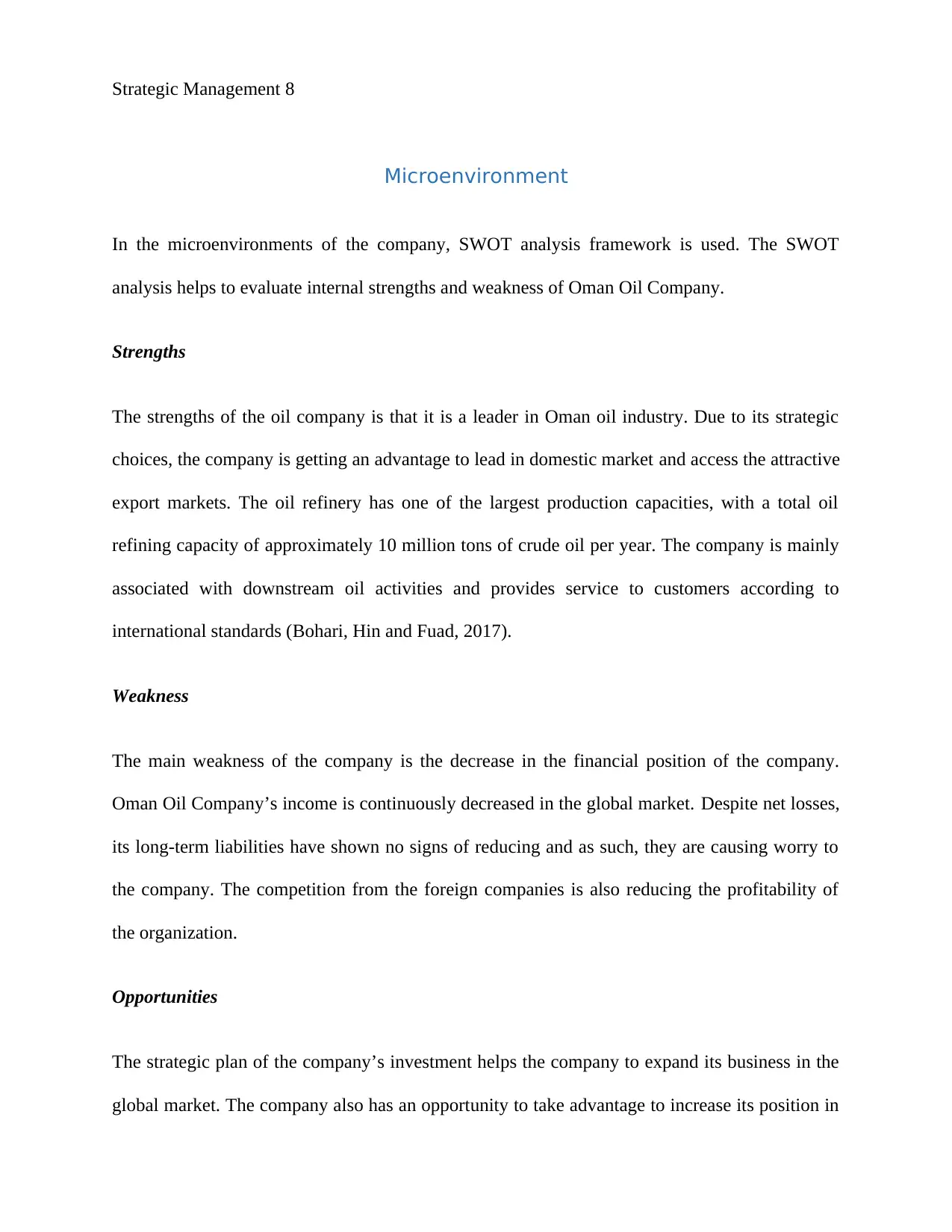
Strategic Management 8
Microenvironment
In the microenvironments of the company, SWOT analysis framework is used. The SWOT
analysis helps to evaluate internal strengths and weakness of Oman Oil Company.
Strengths
The strengths of the oil company is that it is a leader in Oman oil industry. Due to its strategic
choices, the company is getting an advantage to lead in domestic market and access the attractive
export markets. The oil refinery has one of the largest production capacities, with a total oil
refining capacity of approximately 10 million tons of crude oil per year. The company is mainly
associated with downstream oil activities and provides service to customers according to
international standards (Bohari, Hin and Fuad, 2017).
Weakness
The main weakness of the company is the decrease in the financial position of the company.
Oman Oil Company’s income is continuously decreased in the global market. Despite net losses,
its long-term liabilities have shown no signs of reducing and as such, they are causing worry to
the company. The competition from the foreign companies is also reducing the profitability of
the organization.
Opportunities
The strategic plan of the company’s investment helps the company to expand its business in the
global market. The company also has an opportunity to take advantage to increase its position in
Microenvironment
In the microenvironments of the company, SWOT analysis framework is used. The SWOT
analysis helps to evaluate internal strengths and weakness of Oman Oil Company.
Strengths
The strengths of the oil company is that it is a leader in Oman oil industry. Due to its strategic
choices, the company is getting an advantage to lead in domestic market and access the attractive
export markets. The oil refinery has one of the largest production capacities, with a total oil
refining capacity of approximately 10 million tons of crude oil per year. The company is mainly
associated with downstream oil activities and provides service to customers according to
international standards (Bohari, Hin and Fuad, 2017).
Weakness
The main weakness of the company is the decrease in the financial position of the company.
Oman Oil Company’s income is continuously decreased in the global market. Despite net losses,
its long-term liabilities have shown no signs of reducing and as such, they are causing worry to
the company. The competition from the foreign companies is also reducing the profitability of
the organization.
Opportunities
The strategic plan of the company’s investment helps the company to expand its business in the
global market. The company also has an opportunity to take advantage to increase its position in
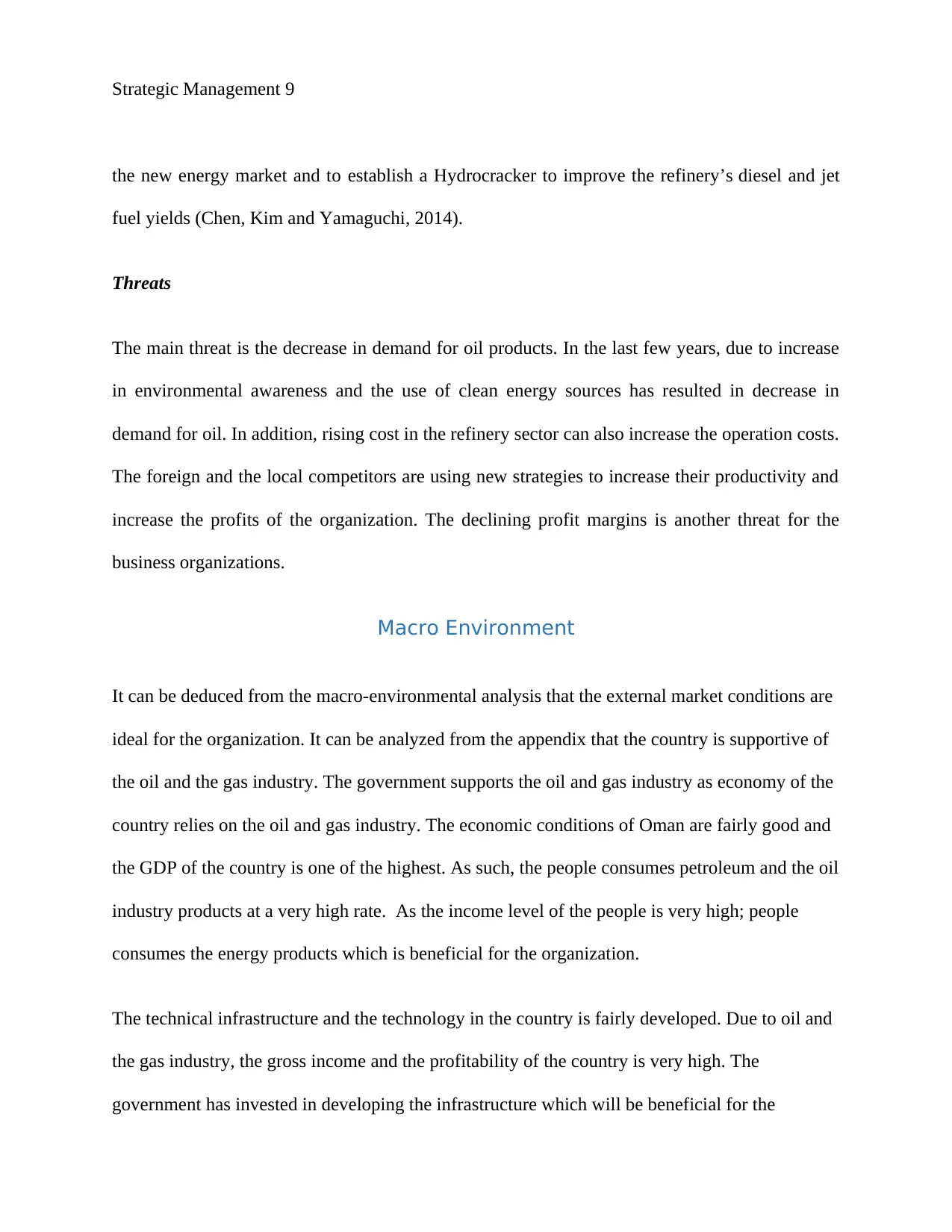
Strategic Management 9
the new energy market and to establish a Hydrocracker to improve the refinery’s diesel and jet
fuel yields (Chen, Kim and Yamaguchi, 2014).
Threats
The main threat is the decrease in demand for oil products. In the last few years, due to increase
in environmental awareness and the use of clean energy sources has resulted in decrease in
demand for oil. In addition, rising cost in the refinery sector can also increase the operation costs.
The foreign and the local competitors are using new strategies to increase their productivity and
increase the profits of the organization. The declining profit margins is another threat for the
business organizations.
Macro Environment
It can be deduced from the macro-environmental analysis that the external market conditions are
ideal for the organization. It can be analyzed from the appendix that the country is supportive of
the oil and the gas industry. The government supports the oil and gas industry as economy of the
country relies on the oil and gas industry. The economic conditions of Oman are fairly good and
the GDP of the country is one of the highest. As such, the people consumes petroleum and the oil
industry products at a very high rate. As the income level of the people is very high; people
consumes the energy products which is beneficial for the organization.
The technical infrastructure and the technology in the country is fairly developed. Due to oil and
the gas industry, the gross income and the profitability of the country is very high. The
government has invested in developing the infrastructure which will be beneficial for the
the new energy market and to establish a Hydrocracker to improve the refinery’s diesel and jet
fuel yields (Chen, Kim and Yamaguchi, 2014).
Threats
The main threat is the decrease in demand for oil products. In the last few years, due to increase
in environmental awareness and the use of clean energy sources has resulted in decrease in
demand for oil. In addition, rising cost in the refinery sector can also increase the operation costs.
The foreign and the local competitors are using new strategies to increase their productivity and
increase the profits of the organization. The declining profit margins is another threat for the
business organizations.
Macro Environment
It can be deduced from the macro-environmental analysis that the external market conditions are
ideal for the organization. It can be analyzed from the appendix that the country is supportive of
the oil and the gas industry. The government supports the oil and gas industry as economy of the
country relies on the oil and gas industry. The economic conditions of Oman are fairly good and
the GDP of the country is one of the highest. As such, the people consumes petroleum and the oil
industry products at a very high rate. As the income level of the people is very high; people
consumes the energy products which is beneficial for the organization.
The technical infrastructure and the technology in the country is fairly developed. Due to oil and
the gas industry, the gross income and the profitability of the country is very high. The
government has invested in developing the infrastructure which will be beneficial for the
⊘ This is a preview!⊘
Do you want full access?
Subscribe today to unlock all pages.

Trusted by 1+ million students worldwide
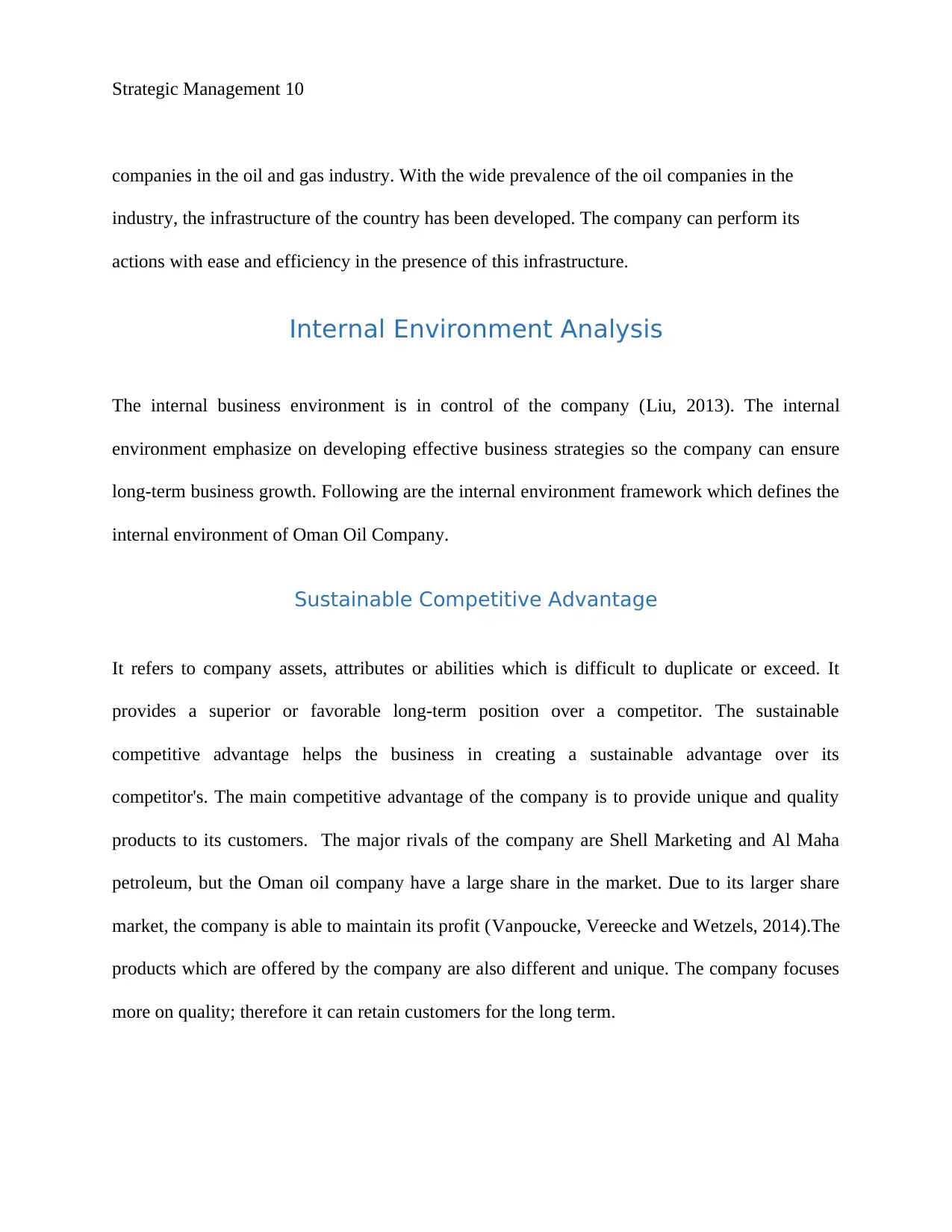
Strategic Management 10
companies in the oil and gas industry. With the wide prevalence of the oil companies in the
industry, the infrastructure of the country has been developed. The company can perform its
actions with ease and efficiency in the presence of this infrastructure.
Internal Environment Analysis
The internal business environment is in control of the company (Liu, 2013). The internal
environment emphasize on developing effective business strategies so the company can ensure
long-term business growth. Following are the internal environment framework which defines the
internal environment of Oman Oil Company.
Sustainable Competitive Advantage
It refers to company assets, attributes or abilities which is difficult to duplicate or exceed. It
provides a superior or favorable long-term position over a competitor. The sustainable
competitive advantage helps the business in creating a sustainable advantage over its
competitor's. The main competitive advantage of the company is to provide unique and quality
products to its customers. The major rivals of the company are Shell Marketing and Al Maha
petroleum, but the Oman oil company have a large share in the market. Due to its larger share
market, the company is able to maintain its profit (Vanpoucke, Vereecke and Wetzels, 2014).The
products which are offered by the company are also different and unique. The company focuses
more on quality; therefore it can retain customers for the long term.
companies in the oil and gas industry. With the wide prevalence of the oil companies in the
industry, the infrastructure of the country has been developed. The company can perform its
actions with ease and efficiency in the presence of this infrastructure.
Internal Environment Analysis
The internal business environment is in control of the company (Liu, 2013). The internal
environment emphasize on developing effective business strategies so the company can ensure
long-term business growth. Following are the internal environment framework which defines the
internal environment of Oman Oil Company.
Sustainable Competitive Advantage
It refers to company assets, attributes or abilities which is difficult to duplicate or exceed. It
provides a superior or favorable long-term position over a competitor. The sustainable
competitive advantage helps the business in creating a sustainable advantage over its
competitor's. The main competitive advantage of the company is to provide unique and quality
products to its customers. The major rivals of the company are Shell Marketing and Al Maha
petroleum, but the Oman oil company have a large share in the market. Due to its larger share
market, the company is able to maintain its profit (Vanpoucke, Vereecke and Wetzels, 2014).The
products which are offered by the company are also different and unique. The company focuses
more on quality; therefore it can retain customers for the long term.
Paraphrase This Document
Need a fresh take? Get an instant paraphrase of this document with our AI Paraphraser
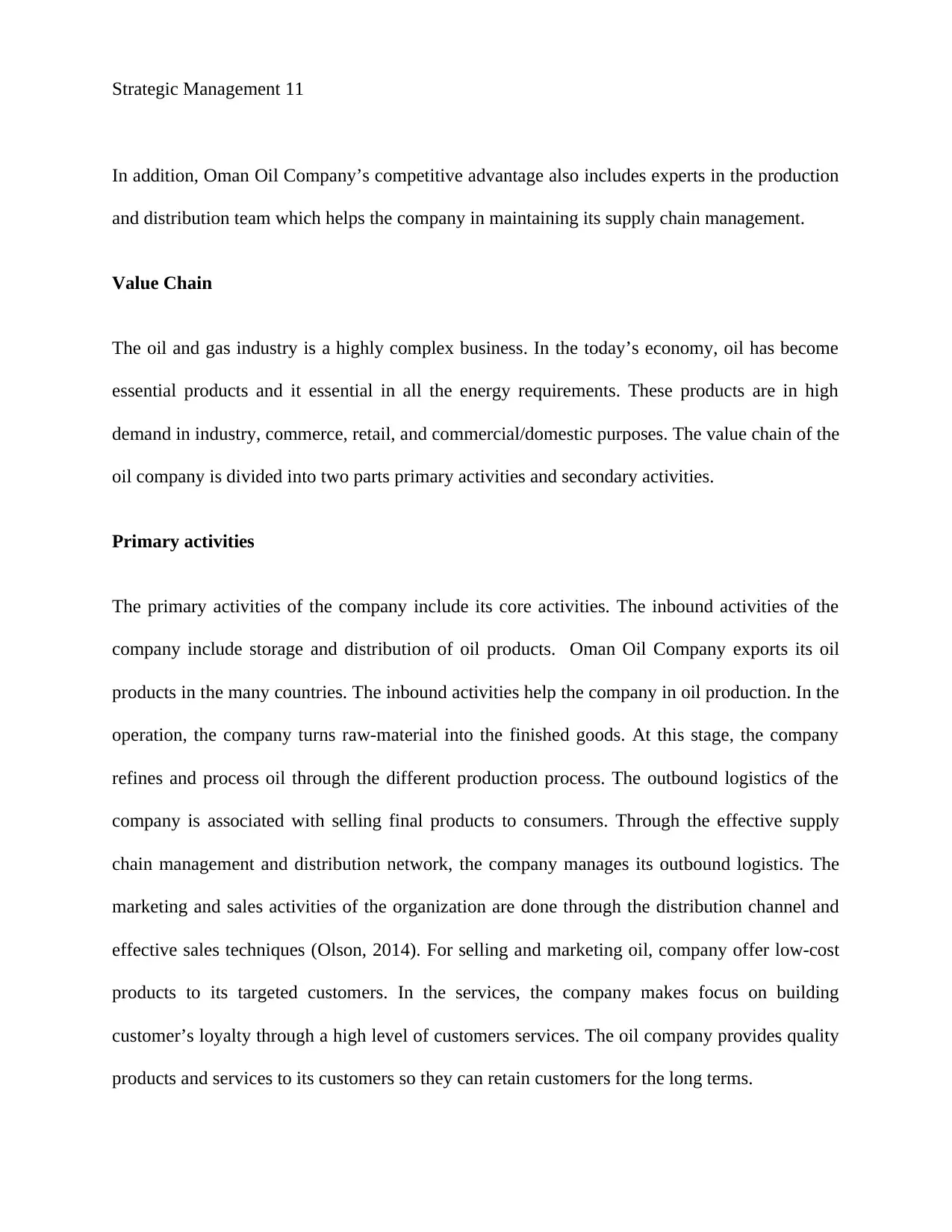
Strategic Management 11
In addition, Oman Oil Company’s competitive advantage also includes experts in the production
and distribution team which helps the company in maintaining its supply chain management.
Value Chain
The oil and gas industry is a highly complex business. In the today’s economy, oil has become
essential products and it essential in all the energy requirements. These products are in high
demand in industry, commerce, retail, and commercial/domestic purposes. The value chain of the
oil company is divided into two parts primary activities and secondary activities.
Primary activities
The primary activities of the company include its core activities. The inbound activities of the
company include storage and distribution of oil products. Oman Oil Company exports its oil
products in the many countries. The inbound activities help the company in oil production. In the
operation, the company turns raw-material into the finished goods. At this stage, the company
refines and process oil through the different production process. The outbound logistics of the
company is associated with selling final products to consumers. Through the effective supply
chain management and distribution network, the company manages its outbound logistics. The
marketing and sales activities of the organization are done through the distribution channel and
effective sales techniques (Olson, 2014). For selling and marketing oil, company offer low-cost
products to its targeted customers. In the services, the company makes focus on building
customer’s loyalty through a high level of customers services. The oil company provides quality
products and services to its customers so they can retain customers for the long terms.
In addition, Oman Oil Company’s competitive advantage also includes experts in the production
and distribution team which helps the company in maintaining its supply chain management.
Value Chain
The oil and gas industry is a highly complex business. In the today’s economy, oil has become
essential products and it essential in all the energy requirements. These products are in high
demand in industry, commerce, retail, and commercial/domestic purposes. The value chain of the
oil company is divided into two parts primary activities and secondary activities.
Primary activities
The primary activities of the company include its core activities. The inbound activities of the
company include storage and distribution of oil products. Oman Oil Company exports its oil
products in the many countries. The inbound activities help the company in oil production. In the
operation, the company turns raw-material into the finished goods. At this stage, the company
refines and process oil through the different production process. The outbound logistics of the
company is associated with selling final products to consumers. Through the effective supply
chain management and distribution network, the company manages its outbound logistics. The
marketing and sales activities of the organization are done through the distribution channel and
effective sales techniques (Olson, 2014). For selling and marketing oil, company offer low-cost
products to its targeted customers. In the services, the company makes focus on building
customer’s loyalty through a high level of customers services. The oil company provides quality
products and services to its customers so they can retain customers for the long terms.
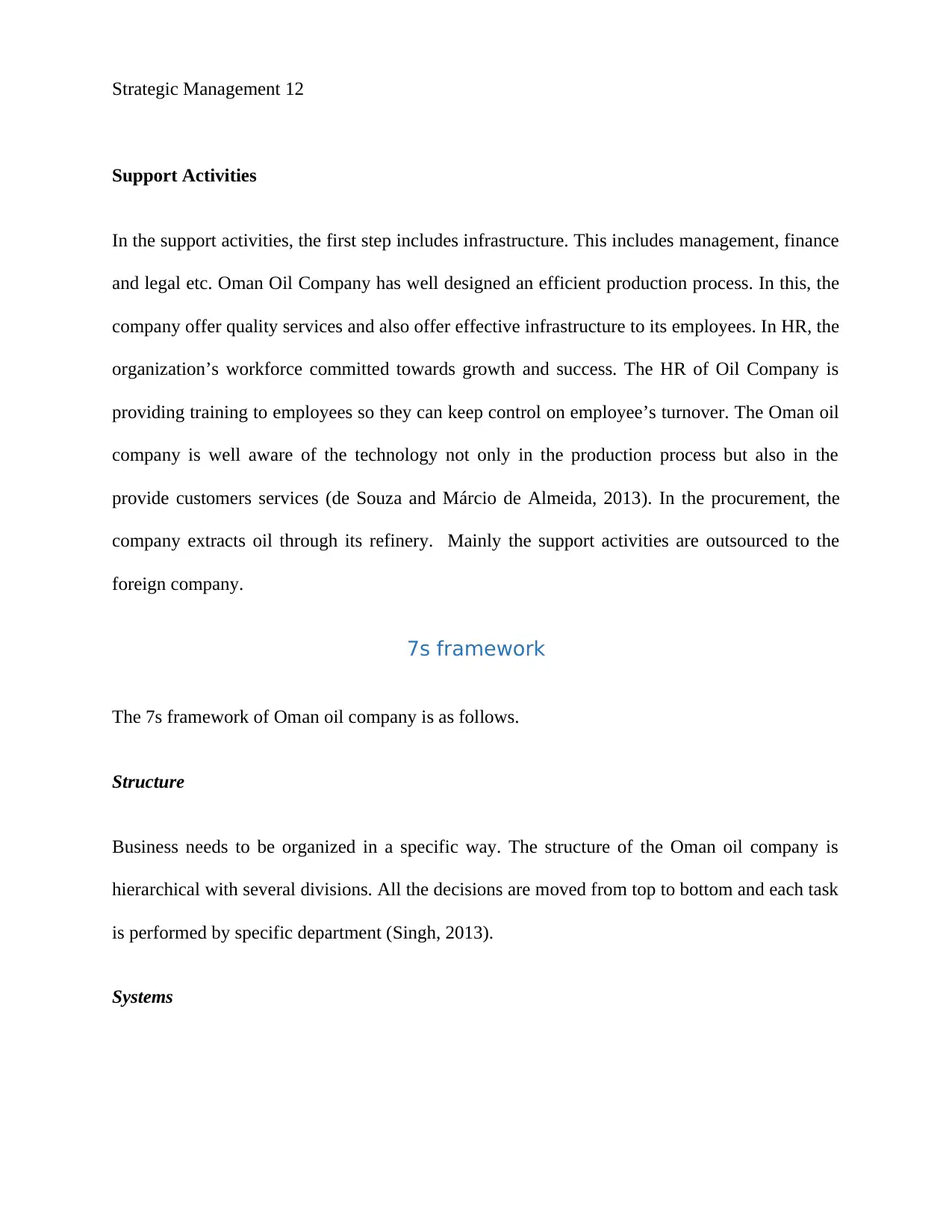
Strategic Management 12
Support Activities
In the support activities, the first step includes infrastructure. This includes management, finance
and legal etc. Oman Oil Company has well designed an efficient production process. In this, the
company offer quality services and also offer effective infrastructure to its employees. In HR, the
organization’s workforce committed towards growth and success. The HR of Oil Company is
providing training to employees so they can keep control on employee’s turnover. The Oman oil
company is well aware of the technology not only in the production process but also in the
provide customers services (de Souza and Márcio de Almeida, 2013). In the procurement, the
company extracts oil through its refinery. Mainly the support activities are outsourced to the
foreign company.
7s framework
The 7s framework of Oman oil company is as follows.
Structure
Business needs to be organized in a specific way. The structure of the Oman oil company is
hierarchical with several divisions. All the decisions are moved from top to bottom and each task
is performed by specific department (Singh, 2013).
Systems
Support Activities
In the support activities, the first step includes infrastructure. This includes management, finance
and legal etc. Oman Oil Company has well designed an efficient production process. In this, the
company offer quality services and also offer effective infrastructure to its employees. In HR, the
organization’s workforce committed towards growth and success. The HR of Oil Company is
providing training to employees so they can keep control on employee’s turnover. The Oman oil
company is well aware of the technology not only in the production process but also in the
provide customers services (de Souza and Márcio de Almeida, 2013). In the procurement, the
company extracts oil through its refinery. Mainly the support activities are outsourced to the
foreign company.
7s framework
The 7s framework of Oman oil company is as follows.
Structure
Business needs to be organized in a specific way. The structure of the Oman oil company is
hierarchical with several divisions. All the decisions are moved from top to bottom and each task
is performed by specific department (Singh, 2013).
Systems
⊘ This is a preview!⊘
Do you want full access?
Subscribe today to unlock all pages.

Trusted by 1+ million students worldwide
1 out of 26
Related Documents
Your All-in-One AI-Powered Toolkit for Academic Success.
+13062052269
info@desklib.com
Available 24*7 on WhatsApp / Email
![[object Object]](/_next/static/media/star-bottom.7253800d.svg)
Unlock your academic potential
Copyright © 2020–2025 A2Z Services. All Rights Reserved. Developed and managed by ZUCOL.




